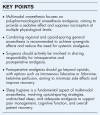The nuts and bolts of multimodal anaesthesia in the 21st century: a primer for clinicians
- PMID: 37724595
- PMCID: PMC10621648
- DOI: 10.1097/ACO.0000000000001308
The nuts and bolts of multimodal anaesthesia in the 21st century: a primer for clinicians
Abstract
Purpose of review: This review article explores the application of multimodal anaesthesia in general anaesthesia, particularly in conjunction with locoregional anaesthesia, specifically focusing on the importance of EEG monitoring. We provide an evidence-based guide for implementing multimodal anaesthesia, encompassing drug combinations, dosages, and EEG monitoring techniques, to ensure reliable intraoperative anaesthesia while minimizing adverse effects and improving patient outcomes.
Recent findings: Opioid-free and multimodal general anaesthesia have significantly reduced opioid addiction and chronic postoperative pain. However, the evidence supporting the effectiveness of these approaches is limited. This review attempts to integrate research from broader neuroscientific fields to generate new clinical hypotheses. It discusses the correlation between high-dose intraoperative opioids and increased postoperative opioid consumption and their impact on pain indices and readmission rates. Additionally, it explores the relationship between multimodal anaesthesia and pain processing models and investigates the potential effects of nonpharmacological interventions on preoperative anxiety and postoperative pain.
Summary: The integration of EEG monitoring is crucial for guiding adequate multimodal anaesthesia and preventing excessive anaesthesia dosing. Furthermore, the review investigates the impact of combining regional and opioid-sparing general anaesthesia on perioperative EEG readings and anaesthetic depth. The findings have significant implications for clinical practice in optimizing multimodal anaesthesia techniques (Supplementary Digital Content 1: Video Abstract, http://links.lww.com/COAN/A96 ).
Copyright © 2023 The Author(s). Published by Wolters Kluwer Health, Inc.
Conflict of interest statement
Figures





Similar articles
-
Impact of opioid-free anaesthesia on postoperative nausea, vomiting and pain after gynaecological laparoscopy - A randomised controlled trial.J Clin Anesth. 2021 Dec;75:110437. doi: 10.1016/j.jclinane.2021.110437. Epub 2021 Jul 3. J Clin Anesth. 2021. PMID: 34229292 Clinical Trial.
-
Multimodal General Anesthesia: Theory and Practice.Anesth Analg. 2018 Nov;127(5):1246-1258. doi: 10.1213/ANE.0000000000003668. Anesth Analg. 2018. PMID: 30252709 Free PMC article. Review.
-
Special indications for Opioid Free Anaesthesia and Analgesia, patient and procedure related: Including obesity, sleep apnoea, chronic obstructive pulmonary disease, complex regional pain syndromes, opioid addiction and cancer surgery.Best Pract Res Clin Anaesthesiol. 2017 Dec;31(4):547-560. doi: 10.1016/j.bpa.2017.11.002. Epub 2017 Nov 16. Best Pract Res Clin Anaesthesiol. 2017. PMID: 29739543 Review.
-
Opioid-free versus opioid-sparing anaesthesia in ambulatory total hip arthroplasty: a randomised controlled trial.Br J Anaesth. 2024 Feb;132(2):352-358. doi: 10.1016/j.bja.2023.10.031. Epub 2023 Dec 2. Br J Anaesth. 2024. PMID: 38044236 Clinical Trial.
-
Recurrence of breast cancer after regional or general anaesthesia: a randomised controlled trial.Lancet. 2019 Nov 16;394(10211):1807-1815. doi: 10.1016/S0140-6736(19)32313-X. Epub 2019 Oct 20. Lancet. 2019. PMID: 31645288 Clinical Trial.
Cited by
-
Sex-Related Analgesic Effects of Opioid-Based Anesthesia and Low-Opioid Anesthesia with Non-Opioid Postoperative Analgesia-A Clinical Observational Study.J Clin Med. 2025 Mar 22;14(7):2163. doi: 10.3390/jcm14072163. J Clin Med. 2025. PMID: 40217614 Free PMC article.
-
Global research frontiers and thematic trends in opioid-free anesthesia over the past 20 years: a bibliometric analysis.Front Pharmacol. 2025 Apr 2;16:1562765. doi: 10.3389/fphar.2025.1562765. eCollection 2025. Front Pharmacol. 2025. PMID: 40242452 Free PMC article. Review.
-
Electroencephalogram monitoring during anesthesia and critical care: a guide for the clinician.J Clin Monit Comput. 2025 Apr;39(2):315-348. doi: 10.1007/s10877-024-01250-2. Epub 2024 Dec 20. J Clin Monit Comput. 2025. PMID: 39704777 Review.
-
Recommendation for the practice of total intravenous anesthesia.J Anesth. 2024 Dec;38(6):738-746. doi: 10.1007/s00540-024-03398-2. Epub 2024 Sep 1. J Anesth. 2024. PMID: 39217587
References
-
- Mulier J, Dekock M. Opioid free general anesthesia, a new paradigm? Best Pract Res Clin Anaesthesiol 2017; 31:441–443. - PubMed
-
- Lasala J, Mena GE, Iniesta MD, et al. . Impact of anesthesia technique on postoperative opioid use in open gynecologic surgery in an enhanced recovery after surgery pathway. Int J Gynecol Cancer 2021; 31:569–574. - PubMed
-
- McEvoy MD, Raymond BL, Krige A. Opioid-sparing perioperative analgesia within enhanced recovery programs. Anesthesiol Clin 2022; 40:35–58. - PubMed
-
- Zhang SM, Chen J, Li H, et al. . Clinical application of enhanced recovery after surgery concept in laparoscopic treatment of pediatric acute appendicitis. Pediatr Surg Int 2023; 39:178. - PMC - PubMed
-
A good example of ERAS practice in a vulnerable population – children – potentially receiving too many opioids.

